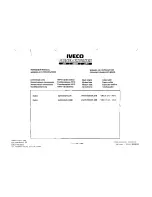
c)
Ignition quality.
Heavy fuels may have very low ignition quality. This
may cause trouble at start and low load operation, particularly if
the engine is not sufficiently preheated. Low ignition quality may
also result in a long ignition delay and can cause a fast pressure rise
and very high maximum pressures. This increases the mechanical
load and can even damage engine components such as e.g.
piston rings and bearings severely. Deposits on the piston top, on
the exhaust valves, in the exhaust system, and on the turbine nozzle
ring and turbine blades can also be expected. The turbocharger
fouling will lead to decreased turbocharger efficiency, and in-
creased thermal load.
A symptom of low ignition quality is diesel knock, i.e. hard, high
pitched combustion noise. The effects of diesel knocking are in-
creased mechanical load on components surrounding the com-
bustion space, increased thermal load, as well as increased
lubricating oil consumption and contamination.
Caution! Although low ignition quality produces long ignition delays, ad-
vancing the injection timing makes things only worse: The fuel will
be injected at a lower compression temperature, and this will
produce an even longer ignition delay!
Ignition quality is not defined, nor limited, in marine residual fuel
standards. The same applies to ISO-F-DMC marine distillate fuel.
The ignition quality of a distillate fuel can be determined accord-
ing to several methods, i.e. Diesel Index, Cetane Index, and Cetane
Number.
The ignition quality of a heavy fuel oil can be roughly determined
by calculating the CCAI (= Calculated Carbon Aromaticity Index)
from the viscosity and density of a fuel.
Determining of CCAI:
CCAI =
r
- 81 - 141 log
10
log
10
(
n
k
+ 0.85)
where
r
= density ( kg/m
3
at 15 °C)
n
k
= kinematic viscosity ( cSt at 50 °C)
Note! An increased CCAI value indicates decreased ignition quality!
CCAI can also be determined (but with limited accuracy) by the
nomogram, see Fig 02-3.
Straight run fuels show CCAI values in the 770 - 840 range, and are
very good igniters. Cracked residues may run from 840 to over 900,
while most bunkers remain in the 840 to 870 range at present.
200549-01
Fuel, Lubricating Oil, Cooling Water
W20/W32/W46, W46F, 32, 32LN
02 - 7
Содержание VASA 6L32
Страница 4: ......
Страница 18: ...Appendix B Welding Precautions 200640 00 6...
Страница 26: ...01 Main Data Operating Data and General Design 32 200634 01 01 8 W RTSIL 32...
Страница 60: ...Appendix A Environmental Hazards 200507 02A 10...
Страница 68: ...Page 7 7 Document No 4V92A0645 Rev j...
Страница 84: ...03 Start Stop and Operation 32 200402 04 03 12 W RTSIL 32...
Страница 98: ...04 Maintenance Schedule 32 200623 01 04 14 W RTSIL 32...
Страница 154: ...07 Tightening Torques and Use of Hydraulic Tools 32 200643 01 07 30 W RTSIL 32...
Страница 162: ...08 Operating Troubles Emergency Operation 32 200402 01 08 8 W RTSIL 32...
Страница 164: ...Specific Installation Data 2005 01 09 2...
Страница 178: ...10 Engine Block with Bearings Oil Sump and Cylinder Liner 32 200150 10 14 W RTSIL 32 34SG...
Страница 216: ...Appendix A Testing of cylinder tightness 32 200142 A 4 W rtsil 20 32 34...
Страница 226: ...13 Camshaft Driving Gear 32 200546 02 13 10 W RTSIL 32...
Страница 253: ...U tube manometer Fig 15 12 401508200050 32 200549 10 Turbocharging and Air Cooling 15 W RTSIL 32 15 19...
Страница 254: ...15 Turbocharging and Air Cooling 32 200549 10 15 20 W RTSIL 32...
Страница 274: ...16 Injection System 32 200627 01 16 20 W RTSIL 32...
Страница 280: ...Fuel System 32 200508 07 17 6 W RTSIL 32...
Страница 314: ...19 Cooling Water System 32 200050 19 14 W RTSIL 32...
Страница 394: ...23 Instrumentation and Automation 32 200115 II 23 60 W RTSIL 32...
















































